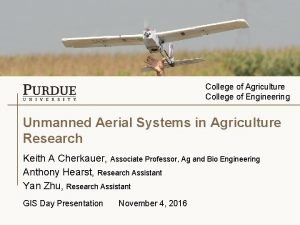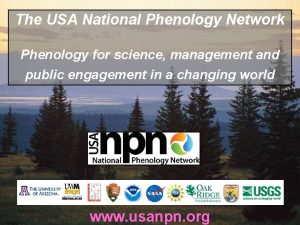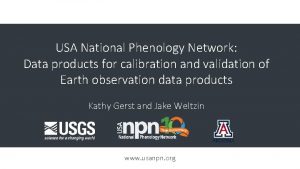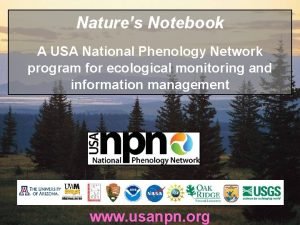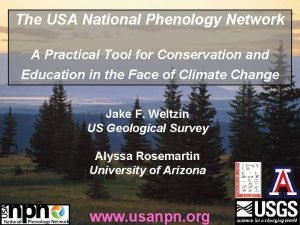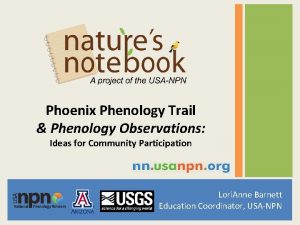USA National Phenology Network Integrating phenology data across















- Slides: 15

USA National Phenology Network Integrating phenology data across spatial and temporal scales Jake F. Weltzin United States Geological Survey www. usanpn. org

A new data resource—a national network of integrated phenological observations across space and time Key Goal Understand how plants, animals and landscapes respond to environmental variation and climate change

Core functions • Create a scientifically based phenology network with broad participation • Create and maintain a national phenology information management system • Develop and promote standardized monitoring protocols • Integrate observations of plants, animals & landscapes across space & time • Create decision support tools for application of phenology data

NPN in a nutshell • National-scale science and monitoring initiative • Agencies, NGOs, academia, the public • Integrates with other science/monitoring networks • Target: 100, 000 observation locations • Plants + animals; contemporary + legacy data • Education & outreach • Integration across spatial and temporal scales

Key sponsors and collaborators…

Services for stakeholders Scientists Citizen Scientists Native American Tribes Specialized Networks National Coordinating Office Information Management Monitoring Programs Communications Public Agencies Educators NGOs Resource Managers

Plant Phenology Monitoring System • Beginning to advanced protocols • Public, managers & scientists • 215 specified species • Status monitoring • Sample intensity + absence data

Animal Phenology Monitoring System • 158 species selected according to a priori criteria • 120 expert reviewers • Standardized monitoring protocols • Independent review workshop • 2010 as on-line beta

Land-surface Phenology Program • Scaling of in-situ observations • Validation of remote imagery • Development of standards 2005 Start of Season (SOS) • Information & data clearinghouse • Research directions and priorities

Information management National Phenology Network Data Contemp-orary Legacy NCO Information Management System User interface Data curation Products Databases Search Synthesis Partners Ancillary Visualizations Metadata Work platform Datasets Decisionsupport Education Research

Key challenges to data integration What we are… • • • We are live today! We are a distributed, bottoms-up national network Broad variety of users/audiences Business to business AND business to consumer Large number of contributing stations Multiple charges: education/outreach, research, decision-support • Interaction with other large networks (CEN, NCCRC, NPS I & M, … ) • Focus

Key challenges to data integration Our data… • Incredibly complex nature of the data (not rainfall!) • real-time (contemporary) • repeated (different variables through time) • one-off, or multiple observers • dynamic standard protocols • customization of methodologies • images • Discovery and ingestion of legacy datasets • large, un-digitized, simple (data rich) • small, complex (metadata rich)

Key challenges to data integration Our data, cont… • • • Metadata standards Integration of contemporary and legacy phenology datasets Integration of external supporting data Web services • Internal (visualization, synthesis products) • External users) Scaling (organismal to digital number) Provenance QA/QC of all data Long-term nature of data (curation) Security

Key challenges to data integration Constraints… • Dynamic landscapes • Administrative • IM • Scientific • Service oriented architecture • Resource constraints – no dedicated $ for IM • Structural constraints – location and ‘. org” • Tendency towards project-centric model

www. usanpn. org
 Usa national phenology network
Usa national phenology network Phenology
Phenology Phenology definition
Phenology definition National emblem of usa
National emblem of usa American national symbols
American national symbols Quote integration
Quote integration Integrating quotes mla
Integrating quotes mla Integrating sensory input with motor output
Integrating sensory input with motor output Differential equation exponential solution
Differential equation exponential solution Integrating classification and association rule mining
Integrating classification and association rule mining Dynamics ax plm
Dynamics ax plm Basic concepts on integrating technology in instruction
Basic concepts on integrating technology in instruction Integrating factor method
Integrating factor method Integrating marketing communication to build brand equity
Integrating marketing communication to build brand equity Key internal forces
Key internal forces Conscious marketing vs csr
Conscious marketing vs csr

